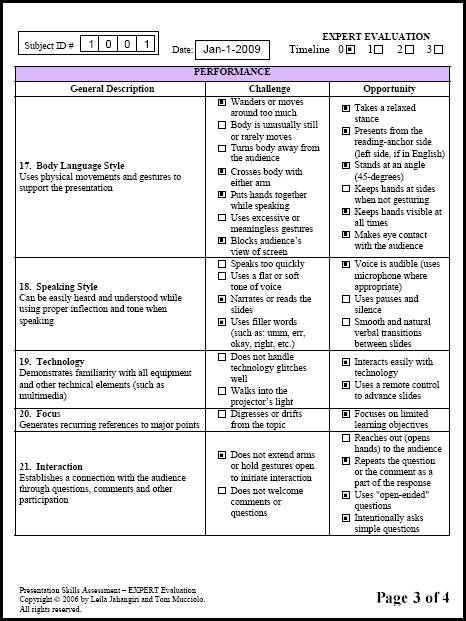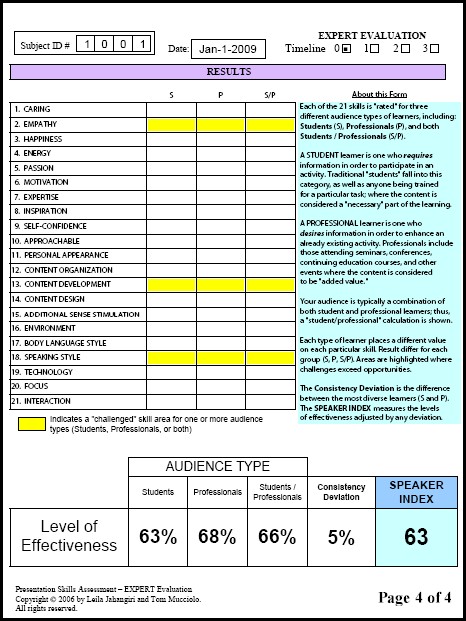

Since 1985, MediaNet has been helping business people become better presenters and more effective communicators. Our unique presentation method has been delivered to audiences through a variety of media including books, CD-ROMs, software, seminars, direct consultation and one-to-one coaching.
In 2006, in conjunction with New York University, we conducted an extensive research project to identify the skills that contribute to a speaker\'s effectiveness. From the published study, we designed a skills evaluation form which measures 80 independent elements to arrive at an effectiveness rating. In January 2010, the Association of American Medical Colleges (AAMC), through a peer-review process, accepted our Presentation Skills Assessment Tools for online publication on the MedEdPORTAL site, a peer-reviewed publication service and repository for medical and oral health teaching materials, assessment tools, and faculty development resources. To expand on the research and the assessment tools, in 2012 we released the book A Guide to Better Teaching which offers and in-depth analysis of each of 21 skills that contribute to presentation effectiveness.
Normally, the skills evaluation is done in a live setting. However, with the ease of interacting over the internet while sharing desktop applications, pre-recorded video or real-time streaming media (You Tube, for example), MediaNet can offer this unique personalized evaluation service to anyone, anywhere.
One-to-one coaching has proven to be one of our most effective and popular teaching methods. It is a service that business people want again and again as they learn new skills to apply to their presentation style. To meet the growing demand and desire for more frequent consultation, MediaNet developed Digital CoachingTM
Digital Coaching delivers a personal, detailed and highly consistent ASSESSMENT based on an online observation of a person\'s presentation. Sessions can be done as content-only delivery, where a presenter gives a slide presentation or webinar, but the presenter is not visible; or, the session can be visual delivery where a presenter delivers content, but is also visible (either live on a web-camera or recorded on video).
CONTENT-ONLY DELIVERY
In many cases, the presenter sits at a PC and shares the desktop using an online meeting tool such as WebEx, GoTo Meeting, or Adobe ConnectNow (or other format that allows desktop display of content). The presenter steps-through a presentation while being coached on content, vocal delivery and interaction. Since the presenter is not visible, everything except body language can be assessed.
A content-only digital coaching session covers opening comments, flow of ideas, slide design challenges, use of stories, example, analogies and other delivery aspects that affect the presentation. This is a perfect coaching venue for those who wish to review a presentation a few days before the event; or, for those who do webinars and want to assess their online effectiveness.
VISUAL DELIVERY
A Digital Coaching session can be done where the presenter is visible. In a live situation, using a web-cam, a presenter can be seen and all skills related to content and delivery, including body language, can be assessed. This is perfect for broadcast situations where a presenter will be speaking to a group from a remote location, either as an individual speaker or as an expert panelist, and needs to develop effective broadcast delivery skills.
Or, a presentation can be pre-recorded and the video can be reviewed during the digital coaching session to point out the various challenges and opportunities associated with the recorded event. The presenter sends a video (5-30 minutes) of a recent presentation; or sends a link to a video clip (such as a YouTube video) and the video is analyzed during the digital coaching session. See our guidelines for how to prepare and send a short video recording of a presentation. This is excellent for presenters who record a portion of a live presentation for analysis, as the ability to observe interaction with an audience can also be assessed.
When assessing skills we identify challenges and opportunities, analyzing over 80 specific elements in the presenter\'s style across 21 skill categories. Based on the review, areas of significant challenge are immediately noted and highlighted. Levels of effectiveness are measured for different audience types (see definitions, below), and a cumulative SPEAKER INDEX is calculated so that a presenter can have an evidence-based value for his or her delivery skills.
In addition, there are THREE different assessment tools we use to measure levels of effectiveness. The STANDARD evaluation is for presentations where a speaker can be seen and uses visual support (such as visual delivery sessions). The WEBINAR evaluation is for presentations where a speaker is not seen but uses visual support (such as content-only sessions). The SPEECH ONLY evaluation is for presentations where a speaker is seen, but does not use visual support (such as public speaking situations).
Below is a SAMPLE EVALUATION FORM, from a Digital Coaching session where a presenter sent a video recording of a presentation. The video was taken from a distance to include the speaker and the display screen with the related slides. Indicated on the form are selected observations of challenges and opportunities across 21 skill categories. A comment area on page two offers suggestions for improvement. Page 4 highlights (in yellow) areas of concern where challenges exceed opportunities. Ratings for different audiences are shown, along with a SPEAKER INDEX.




The sample above shows a speaker who has several "challenges" to overcome and many opportunities still to take. There is a degree of inconsistency across audience types. Based on this evaluation, the speaker is using skills more geared to the "professional learner" and will be more effective in front of groups seeking general concepts, rather than those needing to learn a process. In comparative terms, this speaker would better delivering a marketing presentation than conducting a training session.
The overall speaker index indicates there some additional skills are needed to maximize the potential. Keep in mind that this is only the first evaluation (Timeline 0), without the speaker knowing the individual skill areas that need improvement. For development purposes, a realistic target for this speaker would be an index of about 75, with no more than a 3% deviation, representing about a 20% increase in effectiveness.
Effective speakers usually have a Speaker Index of 80 or higher, with a deviation of no more than 2%. These are speakers who have very few challenges and take advantage of most opportunities, with little or no deviation across audience types.
A Note about Audience Types
From a learning perspective, the research identifies diverse audience types described as: STUDENTS and PROFESSIONALS. When comparing groups of students with groups of professionals, the findings indicate that each group places significance differently on each skill category. The above assessment accounts for these different perspectives and separates audiences into three groups of learners: Students, Professionals and a combination of both.
A STUDENT learner is defined as one who requires knowledge in order to participate in a desired activity. This group not only includes traditional “students”, but it is extended to also include residents, trainees, and anyone who needs to immediately apply learned concepts. So the term “student” is used in this assessment.
A professional is also a “learner” but in a slightly different sense.
A PROFESSIONAL learner is defined as one who desires knowledge in order to add to an existing activity. Professionals include those who incorporate learned concepts over a period of time. Like students, they are learning, but they are using the knowledge to augment an existing practice or job function over a longer period.
In many cases, an audience can be a mix of both student learners and professional learners, and this combination is basically an “average” of the two groups.
Building a Program...
Digital Coaching can be arranged on a one-time basis or in a series of sessions, depending on the level of expertise the presenter intends to achieve. It\'s a great follow-up to a MediaNet seminar or coaching workshop and can act as a supplement for individuals who have difficult schedules or for those who need a more cost-effective solution.
Digital Coaching is excellent for improving the skills of regional and national sales forces which are often costly to train in terms of travel and down-time. This service allows us to EXAMINE your presentation skills, ELIMINATE distractions in your style, and OFFER easy-to-learn suggestions for improvement.
And... any language barriers are eliminated!
Digital Coaching allows you to present in your native language so you can perform in the comfort of your own manner of speaking. The only limitation to the analysis will be in our ability to understand the depth of your stories, examples and analogies. However, nearly every other skill segment can be effectively analyzed regardless of the spoken language.
Videos can be submitted to us in most any format, typically as digital files (MPEG, AVI, QuickTime, etc) on CD or DVD; or, on analog tape such as VHS. Use "best quality" recording settings for all formats. Recordings will be returned, if requested, but we can\'t be responsible for damaged or lost items in transit, so please do not send us your ONLY copy.
You can also upload the video to a streaming video website, such as YouTube and have us review the recording online.
Record a minimum of five (5) minutes of video with audio. If you would like to capture audience interaction, we recommend taping an additional five (5) minutes of that portion. Limit the recording to no more than 30 minutes of the presentation.
If you prefer, you can record several segments, such as the opening, some parts in the middle and the closing.
Use a tripod to maintain a steady shot.
When recording the presenter, keep the shot wide, with the presenter in full view (head to toe) if possible.
Try to include some of the display visuals (slides) as part of the presentation. Or, you can provide a copy of some or all of the presentation separately to allow us to judge the quality of the speaker support images used during the presentation.
When the presenter moves, zoom to follow movement toward or away from the camera and pan to follow movement from left to right, but keep the subject in full view, if possible.
Show the presenter\'s relationship to the audience, screen, and any display equipment, but keep these items at the edges of the frame.
For audience questions, try to capture both the audience member asking the question and the presenter\'s response.
If there is no audience (situations where presenters wish to record a practice performance), then any questions should still be simulated (as if heard) and answered.
Home | About | Contents | Seminars | Stuff | Pricing | What\'s New | Links | Clips